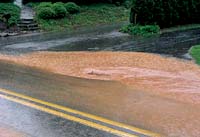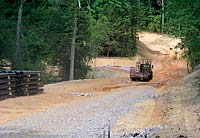Heavy rainfall last month spelled trouble for several construction projects in Asheville’s Kenilworth neighborhood, and residents there are still clamoring for answers.

A July 25 storm dumped 3 inches of rain on the city in a matter of four hours. At the Beaucatcher Heights subdivision off Kenilworth Road, rainfall played havoc with a five-acre clearing, overwhelming a small fill site and silt fence at the construction entrance and sending a torrent of muddy water across the road and into nearby Kenilworth Lake. At 176 Delano Road on the eastern slope of Beaucatcher Mountain, erosion from a quarter-acre home site tore down the mountain, dumping sediment onto neighboring property and into Ross Creek. And along Pickwick Road, not far from the historic Kenilworth Inn Apartments, rain softened a steep bank that construction workers had cleared without putting erosion-control measures in place.
The city has since cited all three developers for violating their approved sediment plans, but at press time, all of them had remedied the situation. And on July 26, the state Divison of Water Quality also cited Beaucatcher Heights for discharging sediment into a stream; the developer has 30 days to “submit a plan for resolution,” according to environmental chemist Kevin Barnett.
Kenilworth resident William Jell, who’s watched this drama-in-the-making unfold since last winter, says he’s “beyond fed up with it. The response from the city, says Jell, “has been completely inadequate.”

Critics were predicting problems at Beaucatcher Heights two years ago, when Charlotte-based developer Brownlyn Associates was thwarted in its plan to build a high-rise condominium at the site. Last year the company came up with a different plan: a 61-unit subdivision of single-family homes on mostly wooded 65 acres.
Many neighbors maintained that already-busy Kenilworth Road was inadequate to handle the comings and goings of logging trucks, heavy equipment and tractor-trailor loads of construction materials the development would require. Residents also worried about what would happen to a historic African-American graveyard on the property.
As recently as last February, Asheville City Council member Jan Davis, referencing Beaucatcher Heights during a discussion about another proposed development, warned, “There’s going to be a subdivision that’s going to be devastating on that mountain.” And some Kenilworth residents say the events of July 25 bear out Davis’s prediction.
The city requires developers to file an erosion-control plan before they can grade any building site. A formal plan is specified for sites larger than 10,000 square feet; for smaller sites such as the Delano tract, just a “sketch plan” is required. The city has 30 days to review a plan and either approve it, attach conditions or reject it outright.
According to city Stormwater Services Manager Chad Pierce, Brownlyn diverged from the city-approved plan by placing fill over a new sewer line. A silt fence on the property also proved unequal to the task, failing during the heavy rains. Pierce says he drove around Kenilworth on the night of July 25 to get a firsthand look at all the problems.
The current city ordinance prescribes a fine of $500 per day for erosion-control violations until a site is brought into compliance. But in fact, fines are seldom levied, says City Engineer Cathy Ball. In all three cases mentioned here, the developers were given seven days to fall in line with the rules they were supposed to follow in the first place, and no fines were assessed.
“Right now, our action is basically to write up a notice of violation and try to get the site up to compliance,” says Ball. “There’s not an immediate penalty or fine, so we find that they don’t pay as much attention to it.”
In the Beaucatcher Heights case, the city was apparently well aware of the problems, having sent the developer a notice of violation on July 20—five days before the big rain. The company has since made “temporary adjustments,” says Pierce, including repairing the failed silt fence and placing seed and straw mulch on the exposed fill. They’ve also filed a revised erosion-control plan with the city, but Pierce says he’s still “not very happy” with it.
Beaucatcher Heights Project Manager Gerald Brown admits that his company “got a little bit lax, with all the dry weather earlier in the summer. There were no small rains to test any erosion-control measures, and suddenly we had a downpour.
“It’s not the kind of attention anyone wants,” he adds. “We’re very sorry it happened. We’re trying to be sensitive to concerns in the neighborhood, and keeping a much closer eye on everything now.”
Meanwhile, City Council will get its first look at a draft version of new storm-water rules on Aug. 21. Aimed at bringing the city into compliance with state-mandated phase II storm-water standards, the new rules include automatic fines that could lead to swifter enforcement, says Ball.
Still, given what they’ve seen of the present system’s failures, Jell and other neighbors say they’re not inclined to take a wait-and-see attitude. “I think the city of Asheville is completely overwhelmed now,” Jell observes. “The developers have better lawyers, better engineers, and this is their business. And the city, I think, can’t keep its fingers on all the holes in the dike—and the developers know this.”
Even if the city does start levying fines, he argues, it won’t be much of a deterrent.
“What really gets developers attention is stop-work orders,” he says. “You fine a developer $500 a day? Well, he’s got a piece of equipment up there that’s costing him $500 a day. That’s nothing. If you want them to comply with what you’re asking them to do, then you give them a stop-work order. Then it costs them; then you’ve got their attention.”
There’s also the question of how well prepared the city is to handle the extra workload. At the moment, six city staffers (including Pierce) are charged with overseeing all projects within the city limits. Too much to keep tabs on? Ball, who is Pierce’s boss, says she’s “not comfortable” commenting on whether her office is understaffed. Instead, she prefers to see how the new storm-water rules will affect the enforcement landscape. “I think once we get this ordinance in place, we’ll be able to assess that a little bit better,” she says.
But that’s cold comfort for Kenilworth residents, who have already seen their roads and waterways and yards fouled by runoff.



Pot, meet Kettle. Not only are these developers lax with their run-off protection, the city of Asheville is just as bed. There is a City of Asheville water project going on Aurora Drive, just off of Kenilworth Drive near Tunnel Rd. They are installing a new water main, which involves digging up a very large area on the side for the length of the street. They had ZERO runoff protection in place. During the same downpour mentioned in this article the runoff was terrible, clogging the streets with mud and making the stream which runs beside Aurora bright red with runoff and silt. To make matters worse I witnessed them digging a trench THROUGH the stream on two occasions with absolutely no runoff protection in place downstream. That is a flagrant violation of the city’s own guidelines BY city employees. After a few complaint calls, some runoff protection has been installed, but IMO it is a day late and a dollar short. These protections should be in place BEFORE construction begins (especially for a city project), but it is easier for these developments and for the city itself to just not do it and see if anyone complains. Since there is basically no risk for a fine, and even if they were fined the amount would be so small, why take the time to do it until they really have to. It’s ridiculous! I agree that the only way to make it count is with a stop work order. That will cost enough to make people pay attention. Did I also mention that it has taken 3 months for the city to install a water line on a road that is a little over a 1/4 mile long? and that they still aren’t finished. At this rate by the time the city finishes overhauling it’s water system they are going to have to start all over again.
As a long-time resident of Kenilworth, I wish to salute the “Mountain X-press” and Kent for doing the work of the big daily, and doing it with more gusto! This is just another example of the City Council ignoring their responsiblities and as an ex planning board chair, I’ve have had my fill of do-nothing fines, fines that are so low that to pay them is to make money in the long run. As to making a typical summer rain, a major flood event, such ignorance just shows that nobody involved with this development ever lived in Asheville before the drought began. Ever wonder why we have such lush forests and so many rare plants? It’s because we have the almost tropcial rains to support such growth. Just wait for the next tropical storm connection! Peter Loewer, The Wild Gardener
I echo the previous salute to MountainX, Kent and all the staff. As far as I’m concerned MountainX is THE paper in town to read. It is definitely the only one that does more than tear news off the AP and print it. As always with MountainX, this article was extremely well researched, well written and to the point. As close as I am to the situation it contained information that I wasn’t aware of. Damn fine job!